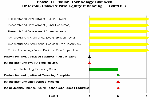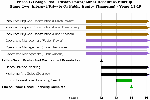NEEP602 Course Notes (Fall 1996)
Resources from Space
Lecture #42 Show me your ROI!
Title: Business Planning for Lunar Resources and Fusion Power
Notes:
Professor Thompson's analysis indicated that a lunar 3He mining activity would be of interest to investors if the government financed its R&D in return for supplies of resources it would need at a lunar base (Lecture #37).
- His analysis of a purely private initiative, focused only on lunar 3He mining would not be financially attractive.
Are any major private initiatives possible in space without the government's financial assistance?
- Of course they are, the precedents being:
- Geosynchronous communication satellites and satellite communications services (many examples)
- Low Earth Orbit communication satellites constellations
- Iridium, Odessey, Geodesic, ORBCOMM, etc.
- Launch services (government an essential customer all cases so far)
- Orbital Sciences' Transfer Orbit Stage, Pegasus, and Taurus
- McDonnell Douglas' Atlas
- EEC's Conestoga
- Lockheed Martin's proposed LMLV family
- Ariane (sort of)
- Are "Really Big" Private Initiatives Possible in Space?
- Similar scale, largely private investment projects:
- TransAlaska Pipeline - 1977 - $8B (~$20B now)
- England to France "Chunnel" - 1995 - $15B
- TransContinental Railroads
- US Surface Communications Infrastructure
- Aggregated Satellite Communications Investments
- Others?
- Most of these provided near-term returns on investment.
- Similar scale, largely private investment projects:
- Must meet national and international regulatory requirements
- Launch licenses (DOT)
- Communication frequency allocations (FCC and ITU)
- Environmental impact (EPA and international precedent)
- Outer Space Treaty obligations (Dept. of State)
- Other
One means of attracting private financing would be to build-in early investment returns as well as a source of cash flow during the early R&D period.
- Key business element is financing R&D, as Professor Thompson has shown
- He also has shown that if the government assumes the burden of financing
mining R&D, a reasonable return on investment can be expected.
- Probably cannot count on this possibility in the foreseeable future (see for example, Grim Budgets Spur Call to Action, Science, v 272, April 26, 1996, p 477.)
- He also has shown that if the government assumes the burden of financing
mining R&D, a reasonable return on investment can be expected.
- Full private financing may become possible by combining the lunar 3He mining
initiative with the terrestrial 3He fusion electric power initiative.
- Investment risk and R&D financing requirements reduced by sales of spin-off fusion technologies (Lectures #26 and 27)
- Future returns on investment also increased by returns from sales of fusion
electric power plants and/or electricity in addition to sales of lunar 3He
and by-products.
 Introduction of fusion technology as a function of Q (power in = fusion power produced)
Introduction of fusion technology as a function of Q (power in = fusion power produced)
- contracts to supply government with technology, resources, power, and/or space access could reduce total private financing required
Potential Business Implementation Schedule for the hypothetical, purely privately financed, INTERLUNE, INC.
-
This schedule is only one of many such possible schedules that might be devised for 3He or other space resource development.
To the extent currently possible, this schedule allows for many of the regulatory, technical, and financial uncertainties that always accompany projects of this magnetude.
Key Business Assumptions related to INTERLUNE, INC.
- An alternative to fossil fuels for the generation of electrical power will be required early in the 21st Century (Lectures #4 and 41).
- 3He fusion is a scientifically sound concept (Lectures #26 and 27)
- 3He fusion systems are commercially feasible provided fuel prices are competitive and R&D financing available (Lecture 37)
- 3He fusion power is politically and environmentally defensible (Lectures #39 and 43)
- Lunar 3He resources can be extracted at commercially viable costs (TBD but likely as per Lectures #22 and 37)
- Permanently occupied settlements on the moon are feasible (Lecture 22).
Timelines:





Competition
- Conservation
- Coal powered plants (Lectures #4 and 41)
- Natural gas or gasified coal plants (Lectures #4 and 41)
- Tritium and deuterium based fusion concepts suffer from
two problems (Lectures
#26 and 27):
- Very large magnets and very complex reactor systems are required to contain
and control the fusion plasmas
- This will make power plants very costly
- Very large magnets and very complex reactor systems are required to contain
and control the fusion plasmas
- Neutrons are the primary reaction product
- To extract energy these neutrons must be adsorbed in the reactor walls,
giving up heat
- This heat is extracted at efficiencies of 35-40%
- The adsorbed neutrons produce radioisotopes in the reactor walls
- This requires the walls to be replaced every few years and handled as high level radioactive waste
- This also requires fail safe cooling systems to avoid meltdowns in the case of a loss of primary cooling
- Plant decommissioning will be complex and expensive
- To extract energy these neutrons must be adsorbed in the reactor walls,
giving up heat
- These problems and their consequences do not exist with 3He fusion
(Lectures
#26 and 27)
- Relatively simple plant designs should be possible if IEC technology matures
- Protons are the primary reaction product
- Electricity can be produced by direct conversion at efficiencies as high as 70%
- Little radioactive waste is produced
- No loss of cooling problems exist
- Plant decommissioning will be routine, when required
- Modern Nuclear fission plants
(Lecture #25) could
be competitive with 3He fusion, however:
- Policies limiting development of breeder reactors and/or reprocessing of spent fuel will severely limit long term viability of fission technology
- Problems with waste disposal and decommissioning will add further uncertainty
- Political viability remains uncertain due to perceived levels of risk - Brown's Ferry, Three Mile Island, Chernobyl, and ----- don't help.
- Much of the rest of the world is headed in this direction now (see Abelson, P.H., 1996, Nuclear Power in East Asia, Science, v 272, April 26, 1996, p465.
- Terrestrial solar energy may be important regionally but will suffer from
several practical limitations as a global energy source that can meet every
growing demand
(Lectures #4 and
41)
- Geographical limits to direct application
- Cost of storage and transport for indirect application
- Net environmental impact of manufacturing and operation
- Technical reliability
- Unsubsidized cost
- Greatest potential may be biologically catalyzed hydrogen generation
- Lunar or satellite solar power needs to be evaluated against lunar 3He, but major technical and political issues remain (Lectures 32 and 33)
References:
 |
|
University of Wisconsin Fusion Technology Institute · 439 Engineering Research Building · 1500 Engineering Drive · Madison WI 53706-1609 · Telephone: (608) 263-2352 · Fax: (608) 263-4499 · Email: fti@engr.wisc.edu |
Copyright © 2003 The Board of
Regents of the University of Wisconsin System.
For feedback or accessibility issues, contact
web@fti.neep.wisc.edu.
|
 IEC Devices Can Be Built Small
IEC Devices Can Be Built Small Commercial Uses for Neutrons
Commercial Uses for Neutrons High Energy Proton Source Valuable
High Energy Proton Source Valuable